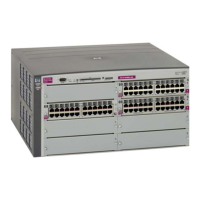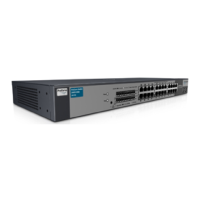Dashboard 33
The following table describes the Switch Spanning Tree Group Information controls:
Table 16 Switch Spanning Tree Group Information controls
Control Description
Spanning Tree State Shows if Spanning Tree is turned on or off for the switch.
VLANs Displays the VLANs that are members of this Spanning Tree Group.
Current Root Displays information about the root bridge for the Spanning Tree. Information includes the
priority (hex) and MAC address of the root.
Path Cost Displays the cumulative path cost to the Current Root.
Root Port Displays the switch port that is connected to the Current Root.
Max Age Specifies, in seconds, the maximum time the bridge waits without receiving a configuration
bridge protocol data unit before it reconfigures the STP network. If the bridge is not the
root bridge, it uses the
MaxAge value of the root bridge.
Hello Time Specifies, in seconds, how often the root bridge transmits a configuration bridge protocol
data unit (BPDU). Any bridge that is not the root bridge uses the root bridge hello value.
Forward Delay Specifies, in seconds, the amount of time that a bridge port has to wait before it changes
from learning state to forwarding state. If the bridge is not the root bridge, it uses the
Forward Delay value of the root bridge.
Hold Time Displays the minimum number of seconds that must elapse between transmissions of
consecutive configuration BPDUs on a port.
Topology Change Counts Displays the number of times the spanning tree topology has changed.
Aging Time Specifies, in seconds, the amount of time the bridge waits without receiving a packet from
a station before removing the station from the Forwarding Database.
Bridge Priority Controls which bridge on the network will become the STP root bridge.
Bridge Hello Time Specifies, in seconds, how often the root bridge transmits a configuration bridge protocol
data unit (BPDU). Any bridge that is not the root bridge uses the root bridge hello value.
Bridge Max Age Specifies, in seconds, the maximum time the bridge waits without receiving a configuration
bridge protocol data unit before it reconfigures the STP network.
Bridge Forward Delay Specifies, in seconds, the amount of time that a bridge port has to wait before it changes
from learning state to forwarding state.
Bridge Aging Time Specifies, in seconds, the amount of time the bridge waits without receiving a packet from
a station before removing the station from the Forwarding Database.
Switch Spanning Tree Port Information
The following table describes the STP port parameters:
Table 17 Switch Spanning Tree Port Information controls
Control Description
Port Displays the port number for each port’s STP information.
Spanning Tree State Shows if Spanning Tree is turned on or off for the port.
Port State Shows the current state of the port. The state field can be blocking, listening,
learning, forwarding, or disabled.
The State field in RSTP or MSTP mode can be one of the following:
Discarding
(DISC), Learning (LRN), Forwarding (FWD), or Disabled (DSB).
Port Priority Helps determine which bridge port becomes the designated port. In a network topology that
has multiple bridge ports connected to a single segment, the port with the lowest port priority
becomes the designated port for the segment.
Port Cost Helps determine the designated port for a segment. Generally speaking, the faster the port,
the lower the path cost. A setting of 0 indicates that the cost will be set to the appropriate
default after the link speed has been auto negotiated.
